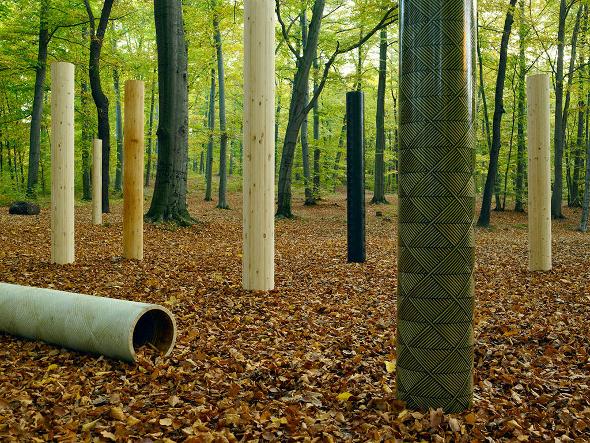Internationale Partnersuche
Innovation & Technologie Angebot
German research institute seeks partners to find new applications or optimise the process for their special formed tubes from densified wood
Country of Origin: Germany
Reference Number: TODE20171012002
Publication Date: 27 June 2019
Summary
A German institute active in materials research developed a solution to form wood pallets into pipes which, compared to solid wood components, have advantages in load bearing capacity and material efficiency. The process is based on thermo- and hygromechanical compaction of wood. By coating the tubes with technical textiles more favourable effects result. They seek for technical cooperation to develop new applications/ optimise the process in terms of technical or research cooperation agreement.
Description
The research at the German institute for timber engineering is focused on innovative applications of constructions made of the building and construction material wood. As a part of the regional university it is doing its research in close cooperation with research institutions and business enterprises from the fields of timber and wood processing, mechanical engineering as well as the textile and composite industries.
The innovative and patented solution approaches to prevent high quantities of wood residues by using residual wood of natural forestry.
About the process:
The manufacture of pipes or other developable moulds requires the provision of special plates made of densified wood. Various substeps are necessary for their production, in which wood humidity, temperature and forming pressure must match with one another. In the first step, small-format transverse sections will be compressed across to the fibre direction in a heating press by pressures of 5 to 10 MPa.
Thereby, the cell walls will be folded at a low-loss and reversible level. Subsequently, the approximately 2 to 4 centimetre thick bars are glued to plates. Therefore, wide and positive experiences with polyurethane and resorcinol resins exist. In the next step, the plates are treated with heat and moisture. This takes place in a steam chamber at about 90° C, followed by the formation of the plate to the tube and the gluing of the final joint.
In the process, the folding of the densified wood cells is completely or partially cancelled out and used as a deformation potential. The finished tube remains fixed until it cools down.
Now it is possible to coat it with an outer strengthening layer in form of technical textiles, such as glass fibres, carbon fibres or aramid fibres, e.g., in the form of woven fabrics. So far, glues have been used based on epoxy resin, polyester and polyurethane. In principle, sheathing with natural fibres is possible as well.
Up to now, moulded wood tubes are used as load-carrying components. Now partners from industry and/ or research are sought to develop jointly new applications and/ or optimise the manufacturing process of plates, pipes and further profiles in terms of a research cooperation agreement or a technical cooperation agreement.

Advantages and Innovations
At the Institute, wood pallets are formed into tubes which, compared to other solutions, have main advantages, e.g. in load bearing capacity and material efficiency.
Conventionally, in the production of components and constructions from wood, methods are used which are based on the combination of sawn timber or wood-based materials with mechanical connection means. For this purpose, the side cuts (cuttings of small cross-sectional dimensions) arising in sawmill cannot be used.
The innovative patented method of wood shaping makes it possible to use this or other residual wood in the near-natural forestry. It is suitable for coniferous and deciduous wood, also fast growing wood types from plantation cultivation are usable. Other forms and profiles which can be unwound can also be produced, while the degree of compaction and the wood thickness determine possible cross-sectional shapes. As a result of the compaction, the strength and stiffness characteristics of the wood species used are also improved.
Technical textiles can be glued onto the moulded profiles. This outer coating makes it possible on the one hand, further increase strengths and stiffness, on the other hand the wood is protected from external influences, in particular moisture.
This improves the application possibilities in indoor and outdoor areas, e.g. as a support in residential and social construction or as a supporting element in lightweight construction.
Stage Of Development
Prototype available for demonstration
Stage Of Development Comment
Numerous studies and publications are available for the production of plates made of compacted wood and for the production of tubes. Up to now, individual load tests of pipes up to 2.6 metres in length have been carried out without and with external textile reinforcement.
For practical testing, it is planned to use tubes reinforced with carbon fibres as fundamental elements of a wind turbine. In particular, findings on weathering and shape stability are expected.
Requested partner
Investors, research institutions and industrial enterprises are being sought as partners in the fields of construction, architecture, mechanical engineering, forestry. Partners with expertise in lightweight construction, ecological construction, composite structures, and/ or wood recycling are highly welcome.
It is expected that partners contribute its ideas and experiences for the shaping of wood and supplements according:
- Optimisation and automation of the production process of plates, pipes or other profiles
- Development of composite components and joining techniques
- Development of new applications
Cooperation offer ist closed for requests

